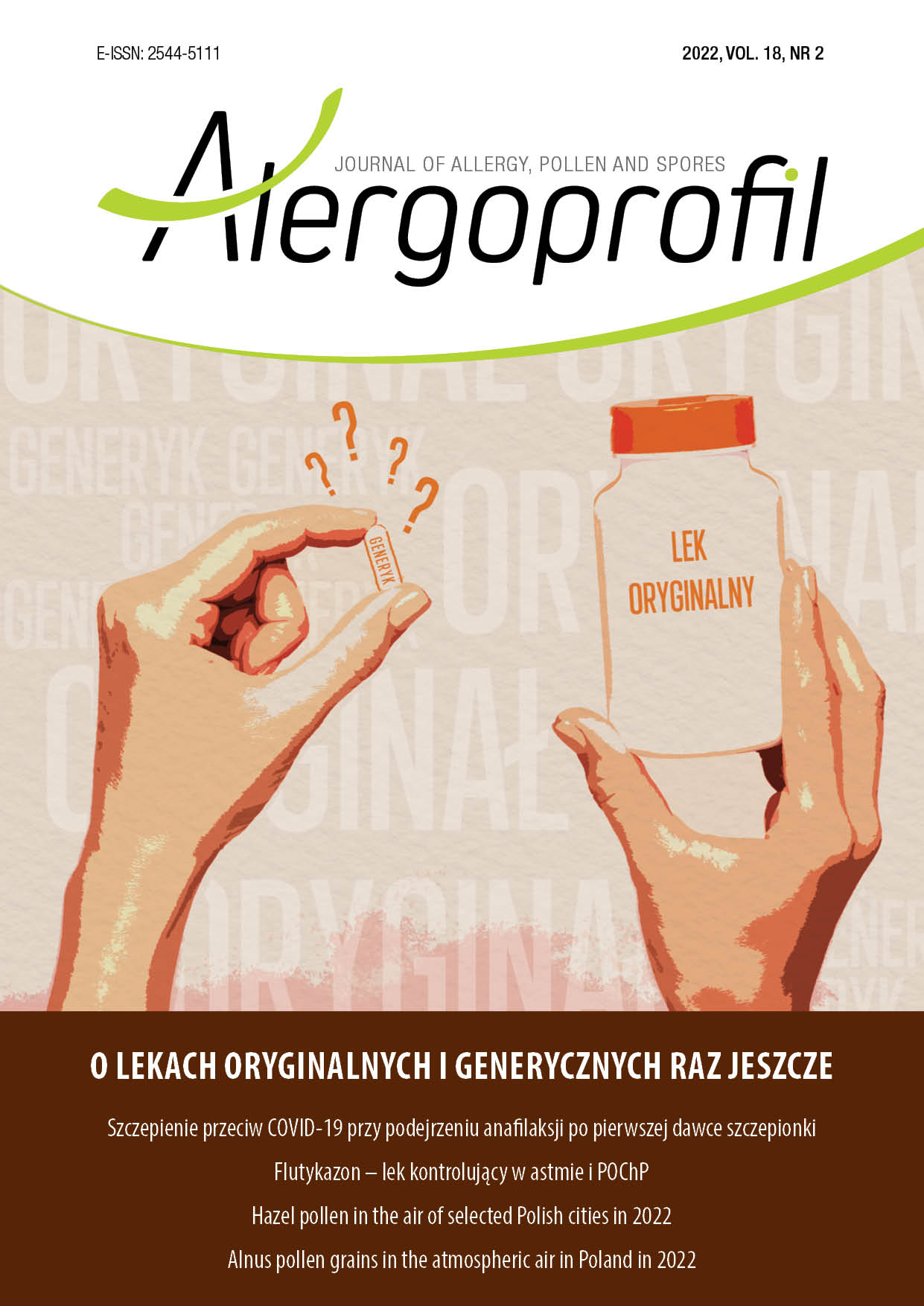Fluticasone – a drug that controls asthma and COPD Review article
Main Article Content
Abstract
Asthma is a chronic inflammatory disease of the airways characterized by variable airflow limitation and bronchial hyperresponsiveness. Inflammation is also present in chronic obstructive pulmonary disease (COPD), but the dominant types of inflammatory cells and the major anatomical site of lesion appear to be different from those in asthma. The pathophysiology of these diseases determines the therapeutic approach. For years, glucocorticosteroids have been the basic drug in the treatment and control (without symptoms, no impact of the disease on the quality of life) of asthma and COPD. The best, most effective and with minimal undesirable effects method of administering glucocorticosteroids is the inhalation route. Inhalations are the drug of choice. Inhaled glucocorticosteroids are essential drugs in the maintenance and rescue treatment of asthma, regardless of the stage of the disease, even in episodic asthma. In the treatment of COPD, they are a drug that supports the basic bronchodilator treatment. Fluticasone propionate is an anti-inflammatory inhaled glucocorticosteroids with high efficacy, excellent safety proven in many studies and with a negligible number of side effects. One type of inhaler is pMDI pressurized inhalers. Currently, all pMDI inhalers have a hydrofluoroalkane (HFA) carrier. The advantages of pMDI are size, ease of use and price. Correct inhalation technique is essential for the effectiveness of asthma and COPD treatment. You should always instruct and control patients with the correctness of taking medications, especially inhalation techniques.
Downloads
Article Details
Copyright: © Medical Education sp. z o.o. This is an Open Access article distributed under the terms of the Attribution-NonCommercial 4.0 International (CC BY-NC 4.0). License (https://creativecommons.org/licenses/by-nc/4.0/), allowing third parties to copy and redistribute the material in any medium or format and to remix, transform, and build upon the material, provided the original work is properly cited and states its license.
Address reprint requests to: Medical Education, Marcin Kuźma (marcin.kuzma@mededu.pl)
References
2. Global Strategy for Asthma Management and Prevention (2021 update). (access: 3.04.2022).
3. Samoliński B, Sybilski AJ, Raciborski F et al. Występowanie astmy oskrzelowej u dzieci, młodzieży i młodych dorosłych w Polsce w świetle badania ECAP. Alerg Astma Immunol. 2009; 14(1): 27-34.
4. GOLD. Global Strategy for The Diagnosis, Management, and Prevention of Chronic Obstructive Pulmonary Disease: 2022 Report . (access: 3.04.2022).
5. Sybilski AJ. GINA 2021 – przełom czy kontynuacja? Alergoprofil. 2021; 17(3): 3-7.
6. Fischer J, Ganellin CR. Analogue-based Drug Discovery. John Wiley & Sons. 2006: 487.
7. https://pubmed.ncbi.nlm.nih.gov/?term=fluticasone+propionate (access: 3.04.2022).
8. Adams N, Bestall JM, Jones PW. Fluticasone versus beclomethasone or budesonide for chronic asthma. Cochrane Database Syst Rev. 2002; (1): CD002310.
9. Lasserson TJ, Cates CK, Jones AB et al. Fluticasone versus HFA-beclomethasone dipropionate for chronic asthma in adults and children. Cochrane Database Syst Rev. 2006; 2: CD005309.
10. Kalayci O, Abdelateef H, Pozo Beltrán CF et al. Challenges and choices in the pharmacological treatment of non-severe pediatric asthma: A commentary for the practicing physician. World Allergy Organ J. 2019; 12(9): 100054.
11. Kulus M, Krenke K, Zawadzka-Krajewska A. Drobne drogi oddechowe a glikokortykosteroidy wziewne w astmie. Alerg Astma Immunol. 2016; 21(4): 182-8.
12. Pawliczak R. Aktualne leczenie inhalacyjne w astmie w świetle nowych zaleceń, ekologii i naszej praktyki lekarskiej. Terapia. W gabinecie lekarza rodzinnego. 2021; 8: 24-30.
13. Usmani OS, Hickey AJ, Guranlioglu D et al. The Impact of Inhaler Device Regimen in Patients with Asthma or COPD. J Aller Clin Immunol Pract. 2021; 9(8): 3033-40.
14. Dhand R, Mahler DA, Carlin BW et al. Results of a patient survey regarding COPD knowledge, treatment experiences, and practices with inhalation devices. Respir Care. 2018; 63: 833-9.
15. Flurhinal. Charakterystyka produktu leczniczego. Data zatwierdzenia: 27.10.2020.

